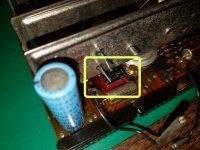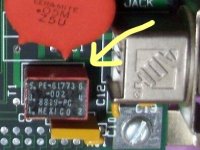It appears to be a Pulse Engineering transistor (part # PE-61773-002). Unfortunately, no datasheet is available anywhere. It looks like only pins 1 and 6 are being used in the applications found so far. At least there is a bit more information to more forward now.
View attachment 60479
Most likely the shorted transistor was responsible for the fuse blows.
If that is a small pulse coupling transformer, likely it will be ok and not responsible for any failure. These types of things are used to couple drive pulses into the base-emitter junctions of switching transistors. They can fail, its just that its pretty rare. The most likely failures on a board like the one in the photo would be the electrolytic caps, transistors, diodes & resistors and Tantalum caps in that very rough order. The large axial tant caps are usually fairly reliable.
Who was it that suggested the transformer was defective, what tests were performed on it ? (They can be awkward to test in circuit sometimes)
For a vintage item like this, the first step is to sit down with pencil & paper and patiently copy out the schematic. That way a structured plan of tests can be made to determine what is wrong.
The other approach is to test every component possible, the transistors and diodes with a meter, the caps with an ESR meter, for shorts and open circuit conditions and any resistors that are open circuit. Look for any parts that are thermally damaged. But this sort of approach won't always win and result in a successful repair, that is why its better to copy out the schematic and attempt to understand how the circuit is supposed to work and have a structure approach to the repair.
Having the schematic also means its possible to deduce the properties of some of the components, like transistors,which can be helpful if they don't have labels or have unusual numbers.
The worst move is shotgun replacements of parts.
It looks like a very high quality board to me.
It sounds like you need someone in your locality to repair it for you. The button shaped power transistors you refer to are T0-3 package types. Some can be NPN, others PNP and some could be Darlington types. In the latter case these can confuse people testing them because they can have internal resistors and a collector-emitter diode on the output device. So its also important to look up the specs of the part being tested (where possible) to correctly interpret the tests.
The second photo you posted shows a different, but similar part on the board in another locality on the same board ? Are there more than one of these transformers on the same board ? and if so why is the one under the heatsink suspect ? In any case if there are two of them, you can compare the properties of each to determine if one is faulty. I notice Pulse Electronics still exists. They appear to have made a lot of pulse coupling transformers.



